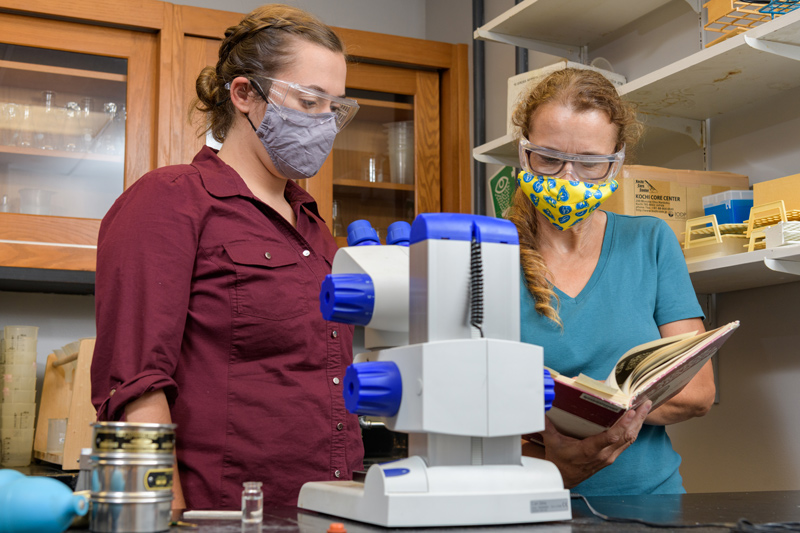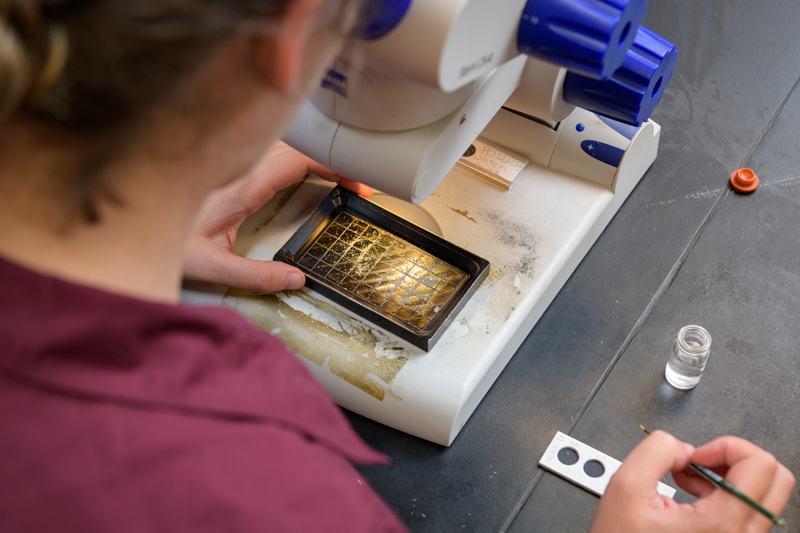


Ancient ocean conditions
Photo by Evan Krape September 17, 2021
UD student spent the summer looking at tiny shells to understand climatic conditions thousands of years ago
University of Delaware student Erin Leathrum spent her summer looking for coiling party hats atop cinnamon buns at the bottom of the ocean. Not literal party hats and cinnamon buns, mind you, but rather microscopic organisms known as foraminifera that resemble them and live in the ocean in intricate shells of calcium carbonate.
These foraminifera are the size of a small grain of beach sand. Over time, their shells become fossil footprints allowing researchers to determine what once occupied the water, as well as the living conditions of the water where they once lived.
Leathrum worked with Katharina Billups, professor in the School of Marine Science and Policy, as part of the UD Summer Scholars program. The program enables selected undergraduates, generally sophomores and juniors, to conduct in-depth research or creative work with university faculty. Students in the Summer Scholars program work on their projects full-time for 10 weeks over the course of the summer.
Investigating an era from the present to 140,000 years ago, Leathrum looked at two specific foraminifera varieties and said they serve as a good proxy to estimate the natural climate variability thousands of years ago because they favor different environmental conditions.
“The left coiling sinistral form favors warmer conditions, and then the right coiling dextral form favors colder conditions,” said Leathrum, an honors marine science major with a concentration in oceanography. “So you can use that as a proxy to reconstruct the gyre circulation over time.”
These proxies are important because physical oceanographers can’t take direct measurements of climatic conditions thousands of years ago.
“We have to use proxies, which come with a set of uncertainties and assumptions we have to make, but we’re looking at the big-picture changes,” said Billups. “The idea is to get information on the natural climate variability. For example, how warm was the ocean, how quickly did sea surface temperatures change without any human impact — because we’re going back thousands or even millions of years in some cases.”

Billups said that the foraminifera are unicellular organisms that live in the surface ocean for about one to three months, and then their shells sink to the bottom of the ocean. Over time, they build up a record of sediments.
“The analogy I like to use is to imagine what your house or your room would look like if you never vacuumed,” said Billups. “The layers of dust would build up over time, and they would preserve exactly the potato chip crumbs from three months ago that hang around the bottom and whatever else was there — dog hair, cat hair — and then you take a slice out of that and you can reconstruct what was there.”
Leathrum spent her summer on the Lewes campus looking at specific cores from a site on the northern boundary of the north Atlantic gyre — a circular ocean current.
Using sediment samples collected from the International Ocean Discovery Program, Leathrum’s first job was to clean the samples.
“It’s like going back to what you did in kindergarten out on the playground. You’re sieving and you’re washing mud to a certain size fraction where we find the foraminifera,” said Billups. “They are about the size of a grain of sand, maybe half a millimeter or so and it is Erin’s job to wash, sieve, and retain that fraction, and to then pick the foraminifera we need.”
After the samples were washed, Leathrum looked at them under a microscope to count the separate coiling directions.
The location of the center of the subtropical gyre where the warm water mass is can be found by locating sediments dominated by shells that have the left coiling direction, and then the northern margin of the gyre where it gets colder has sediments that are dominated by shells that have the right coiling direction. How the ratio changes through time tells the researchers something about changes in gyre circulation.
Leathrum said she was drawn to the Summer Scholar opportunity because she participated in the Semester in Residence program last spring where she was also able to work on this project with Billups. The Semester in Residence allows a small number of undergraduate students to study and conduct research on the Lewes campus during the school year.
Through this work, she has been able to realize just how much she enjoys paleoclimate research.
“I wasn’t exactly sure what I wanted to do for a while,” said Leathrum. “Once I started taking some geology classes and more oceanography classes, that’s when I declared the oceanography concentration, and then through this research I have gotten a lot more interested in paleoclimate work.”
Leathrum said that if she could think of one thing specifically that appeals to her about the paleoclimate work, it would have to be how you can learn so much about the ocean from such a small part of it.
“We can learn a lot about the past ocean just through one small little proxy,” said Leathrum. “I’ve just been working with this one proxy, and I’m also really excited to use other proxies to learn more about past climate throughout my career. I think it’s really interesting how much you can learn about large ocean scales through just one little thing.”
Contact Us
Have a UDaily story idea?
Contact us at ocm@udel.edu
Members of the press
Contact us at 302-831-NEWS or visit the Media Relations website

